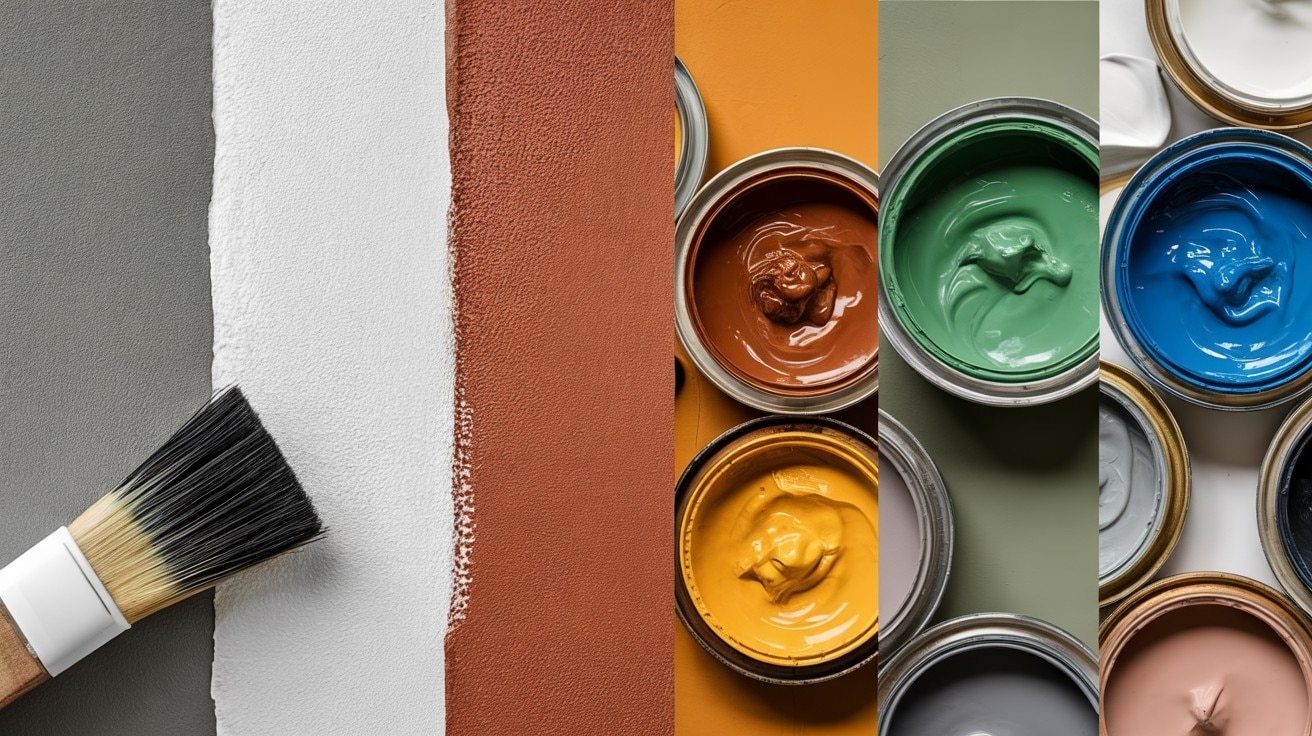Are you stuck with dull, flaking stucco on your home?
I know how hard it can be to find the right paint for stucco surfaces. Most house paints just don’t work well on these rough, porous walls.
After testing many options, I found that stucco needs special paint that can stand up to weather and time.
In this blog, I’ll show you exactly which paints work best for stucco, how to choose the right one, and the steps to get a perfect finish.
By the end, you’ll have all the facts you need to make your stucco look fresh and last for years to come.
What is a Stucco Paint?
Stucco paint is a type of coating made just for stucco surfaces. It’s thicker than normal paint and sticks better to the rough texture of stucco walls.
Unlike regular house paint, stucco paint has special parts that help it:
- Fill in small cracks
- Resist water damage
- Allow moisture to escape from the walls
- Stand up to sun, rain, and time
- Keep its color for many years
Good stucco paint forms a strong but flexible layer. This helps it move with the stucco as it shifts with heat and cold, without cracking.
Types of Paint Suitable for Stucco
Not all paints work well on stucco. Here are the main types that give good results:
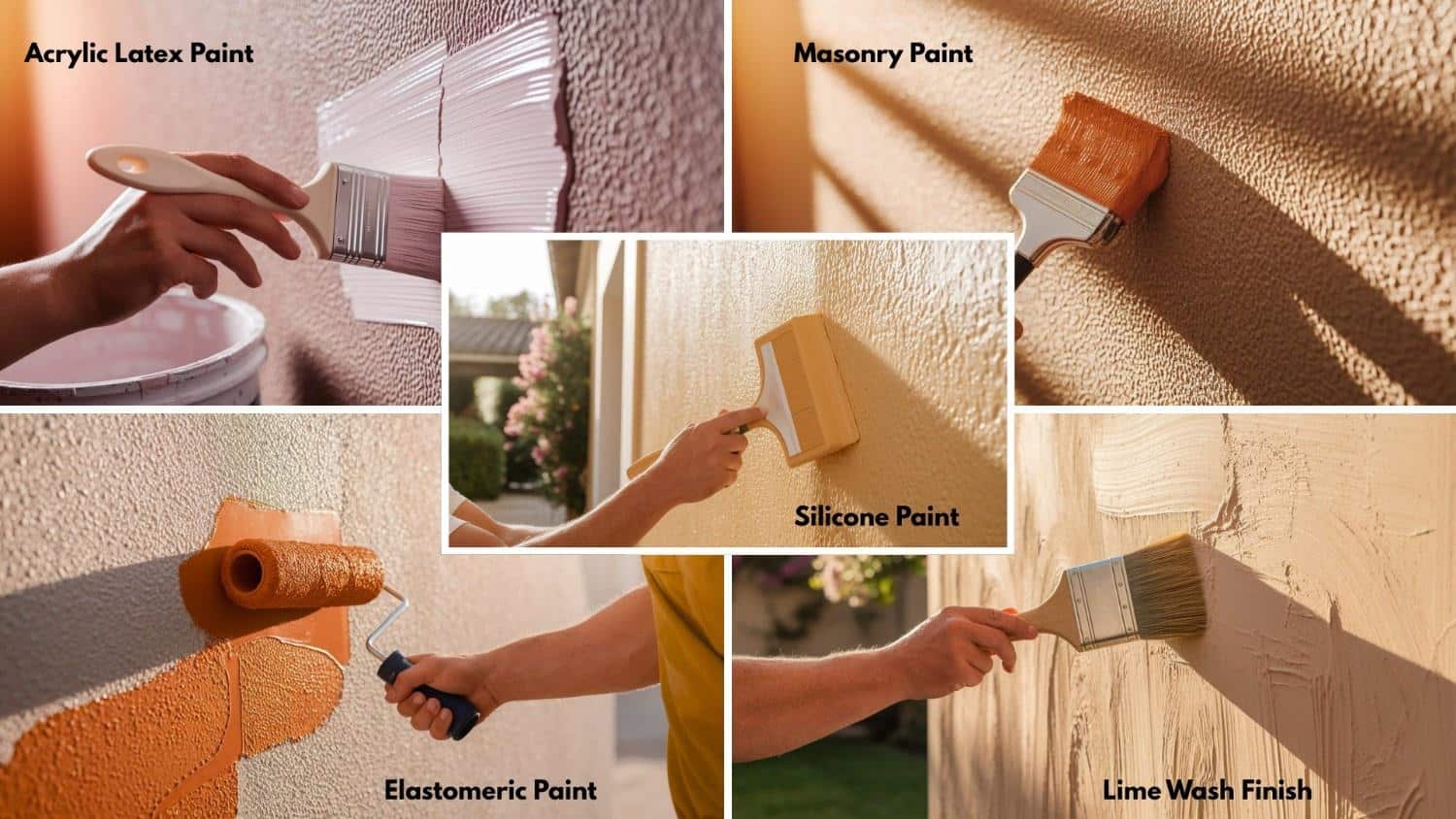
Acrylic Latex Paint
Acrylic latex paint is water-based and easy to use for most stucco homes. It dries fast, cleans up with water, and typically lasts 5-7 years on average. This type of paint offers a good balance between cost and performance for most homeowners.
Elastomeric Paint
Elastomeric paint forms a thick, rubber-like coating that can stretch and flex with the stucco. It fills tiny cracks up to 1/16 inch and provides excellent water protection. With proper application, elastomeric paint can last 8-10 years or more, making it a good long-term option.
Masonry Paint
Masonry paint is specially made for brick, stone, and stucco surfaces. It has a better grip on rough surfaces and often includes water protection features. This medium price range option typically lasts about 7-8 years with proper application and maintenance.
Lime Wash
Lime wash is an old-style, mineral-based coating that gives stucco a soft, matte finish. It allows the stucco to “breathe” well, which helps prevent moisture issues. Though it requires more work to apply, lime wash provides a natural look and can last 5-7 years with proper care.
Silicone Paint
Silicone paint is a newer type with excellent water-blocking properties. It’s very good at stopping rain from penetrating while still allowing inside moisture to escape. Though higher in cost, silicone paint often lasts 10+ years, making it a cost-effective choice over time.
Factors to Consider Before Choosing Stucco Paint
Selecting the right stucco paint involves more than just picking a color. Several important factors will affect how well the paint performs and how long it lasts on your specific stucco surface.
Climate Where You Live
The local weather plays a major role in paint selection. Hot, sunny areas need paint with strong UV protection to prevent fading and breakdown.
Wet regions require more water-blocking capabilities to prevent moisture damage. Very cold places need paint that can flex without cracking during freeze-thaw cycles that cause stucco to expand and contract.
Age of the Stucco
New stucco walls need time to fully cure before painting, usually at least 30 days. Old stucco might need more extensive prep work to create a good painting surface.
Some older traditional stucco works better with lime-based paints that allow for proper breathing and moisture movement through the wall.
Current Stucco Condition
The state of your stucco affects what paint will work best. Walls with lots of small cracks benefit from elastomeric paint that can bridge and seal these openings.
Stucco with moisture issues needs paint with high water blocking but good vapor permeability. Stucco in good shape gives you more options and flexibility in paint choice.
Desired Look
Consider what finish you want for your home. Some paints offer a matte finish while others provide a slight shine.
Think about whether you want a natural, textured look or a more uniform, smooth appearance. The type of paint affects how much of the original stucco texture shows through the final finish.
Budget Concerns
Better quality stucco paints typically cost more upfront but last longer between repaints. Cheaper paints often need more coats for good coverage and may fail sooner.
When comparing costs, think about the total expense over time, including how often you’ll need to repaint, not just the initial price per gallon.
Skill Level for Painting
Some stucco paints require more expertise to apply correctly. Elastomeric paints need careful, even application to perform properly.
Lime wash requires special techniques to achieve its characteristic look. Consider your skill level or budget for professional help when choosing your paint type.
Top 5 Paints for Stucco
When choosing from the many stucco paints on the market, it helps to know what makes each product stand out. These five options offer different benefits depending on your specific stucco needs and project requirements.
Behr Premium Elastomeric Masonry, Stucco & Brick Paint
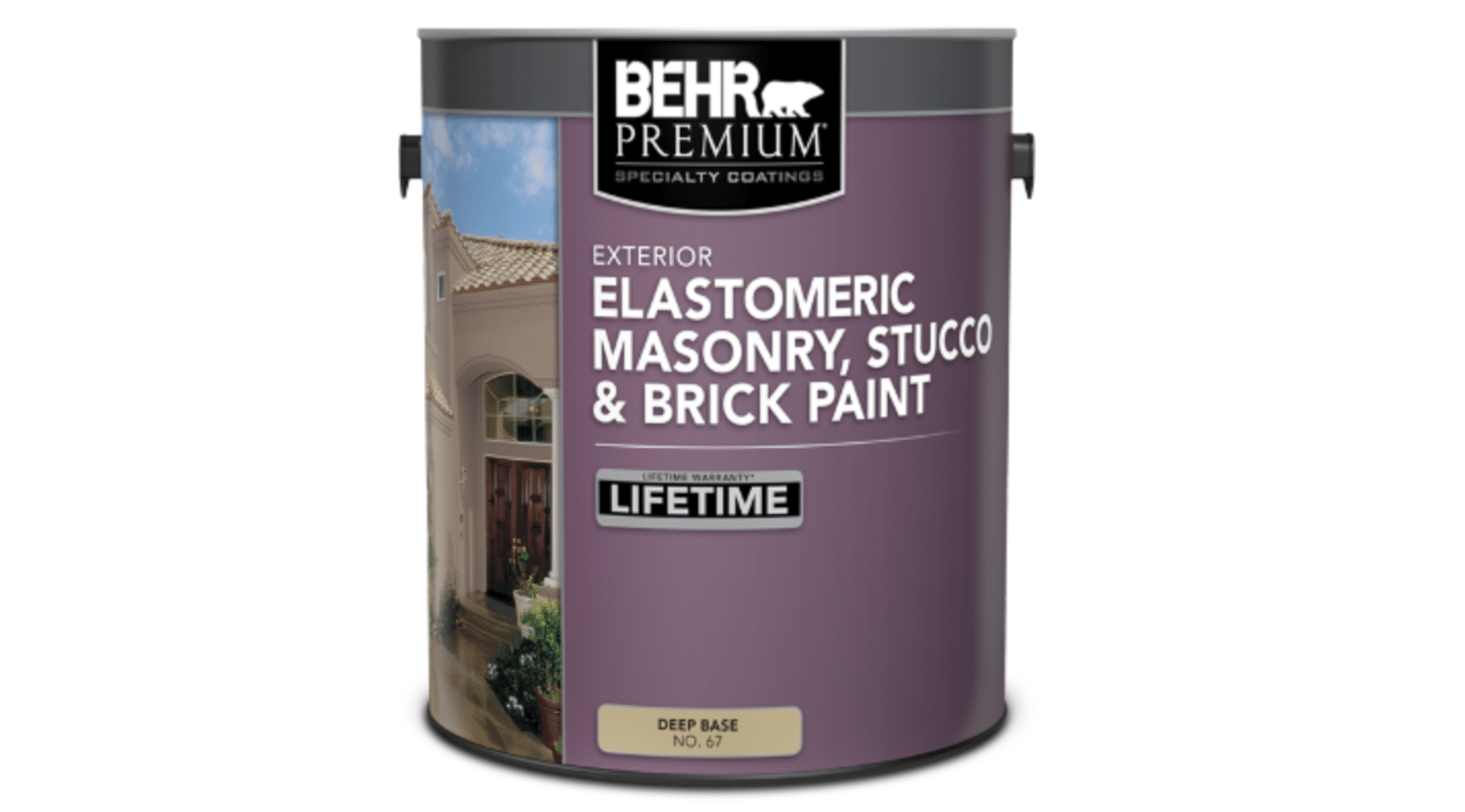
Behr Premium Elastomeric paint creates a flexible coating that can stretch up to 600% to bridge small cracks in stucco surfaces. Its 100% acrylic formula makes a waterproof barrier while still allowing your walls to release trapped moisture. This paint stands up to extreme weather, making it ideal for homes in areas with harsh conditions.
- Withstands 98 mph wind-driven rain and stops water damage
- Covers up to 125 sq. ft. per gallon with a low-sheen finish
- Resistant to dirt, mildew, and high-pH (alkali) surfaces
Kilz Self-Priming Masonry, Stucco, and Brick Paint
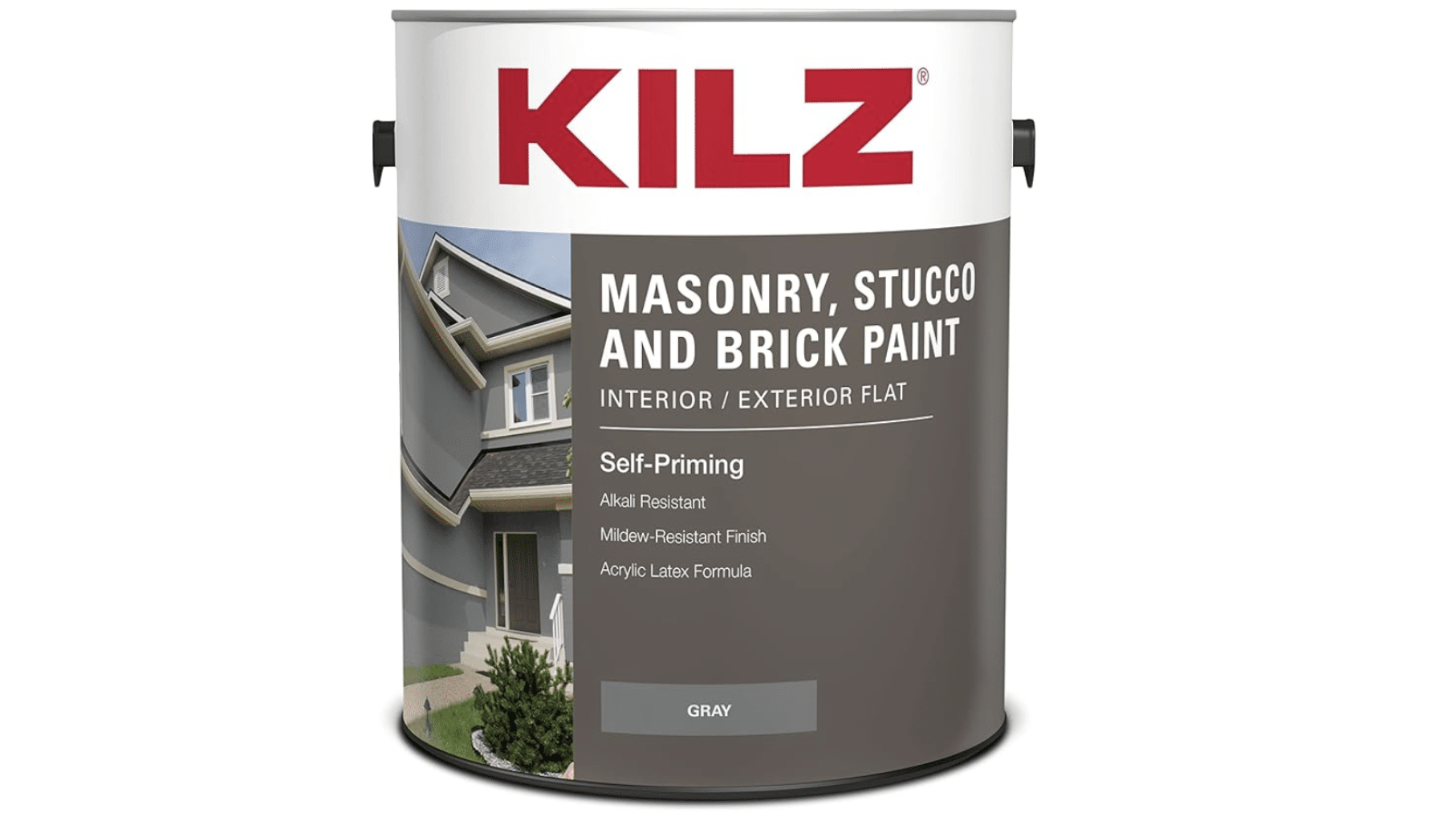
Kilz Self-Priming Masonry paint works on both indoor and outdoor stucco surfaces with its water-based acrylic latex formula. It bonds well to rough textures and creates a water-repellent coat that protects your stucco from moisture damage. The paint can be applied with a roller, brush, or sprayer for easy application.
- Self-priming formula saves time and money on a separate primer
- Alkali-resistant up to pH 12.0 for new stucco applications
- Covers 250-400 square feet per gallon, depending on texture
Valspar Masonry Stucco & Brick Flat Interior & Exterior Tintable Paint
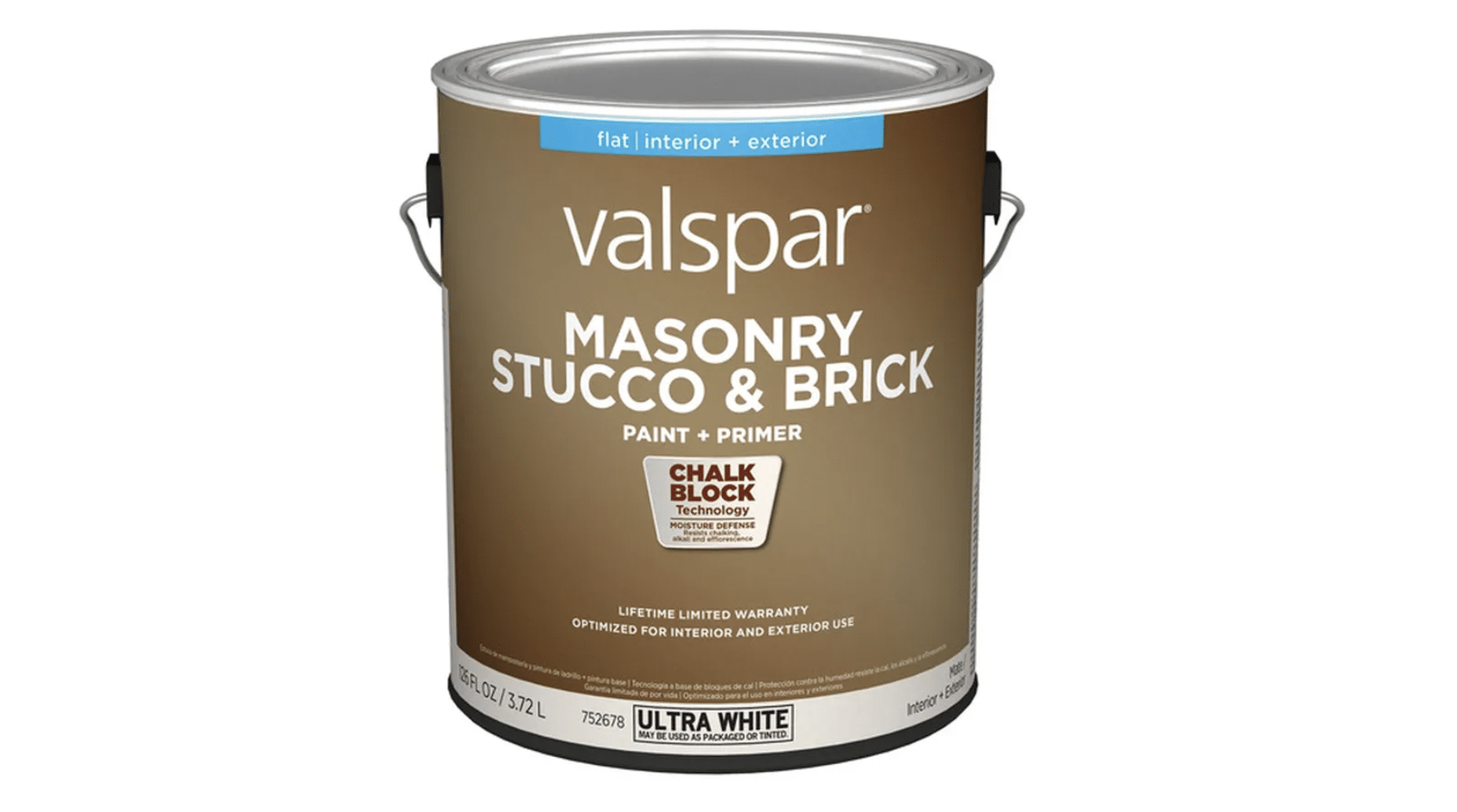
Valspar’s masonry paint features an ultra-flat finish that helps hide surface flaws and imperfections in your stucco. Its Chalk-Block Technology fights chalking, alkali damage, and efflorescence that often affect masonry surfaces. The formula creates a strong bond that resists cracking and peeling while blocking moisture.
- Fade-resistant formula keeps colors looking fresh longer
- Creates a coating that resists mold, mildew, and algae growth
- Backed by a lifetime warranty for long-term peace of mind
Frost Satin Interior/Exterior Masonry, Stucco, and Brick Paint
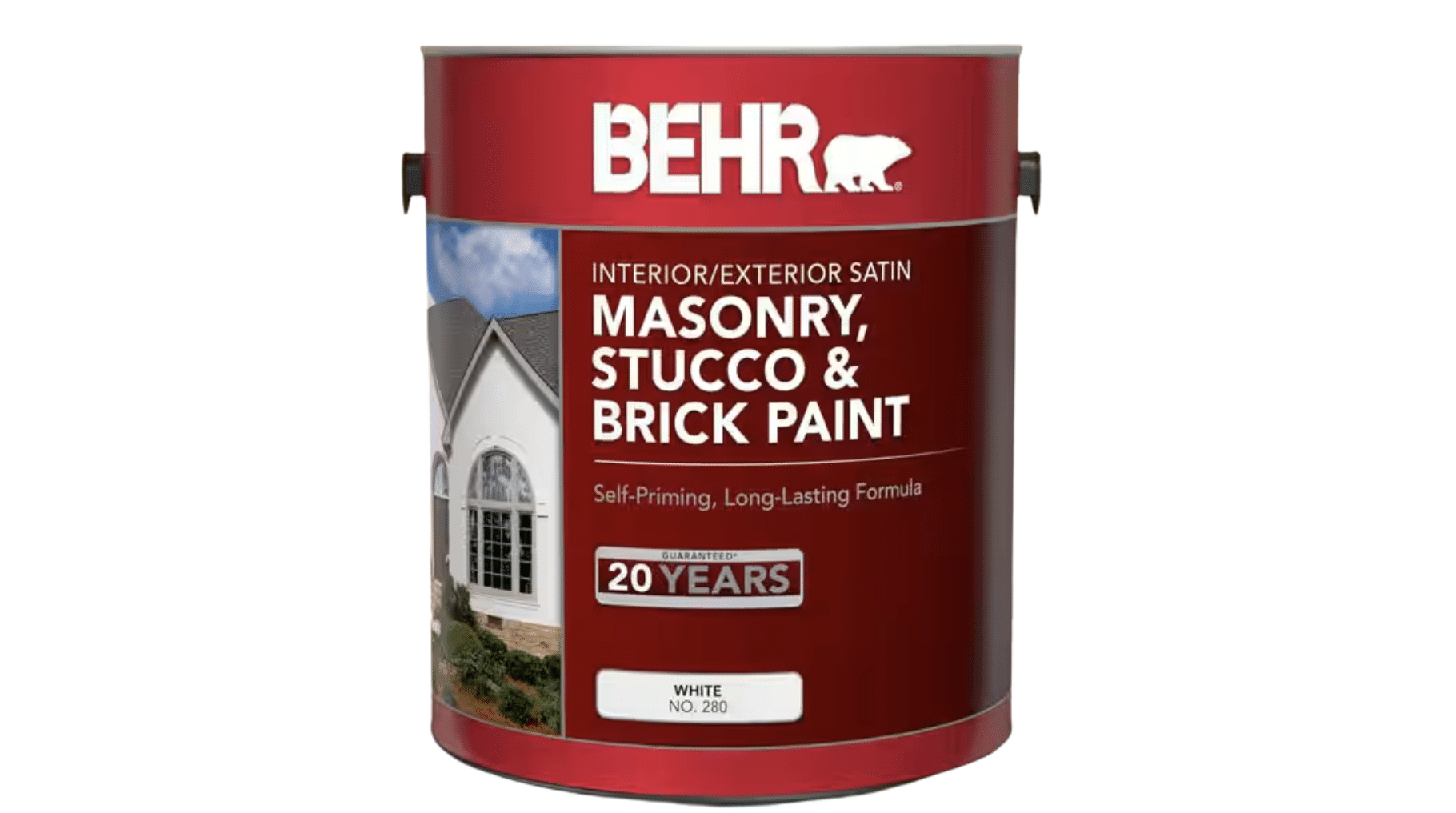
Behr Frost Satin paint offers a 20-year customer satisfaction guarantee with its high-quality acrylic latex formula. The self-priming paint works on both indoor and outdoor stucco, saving time and money on prep work. It delivers good coverage with a satin finish that adds subtle shine to your stucco surfaces.
- Resistant to alkali and mildew, ideal for new or weathered stucco
- Covers 250-400 sq. ft. per gallon for good value
- Self-priming formula with excellent adhesion to rough surfaces
Exterior Acrylic Stucco Finish
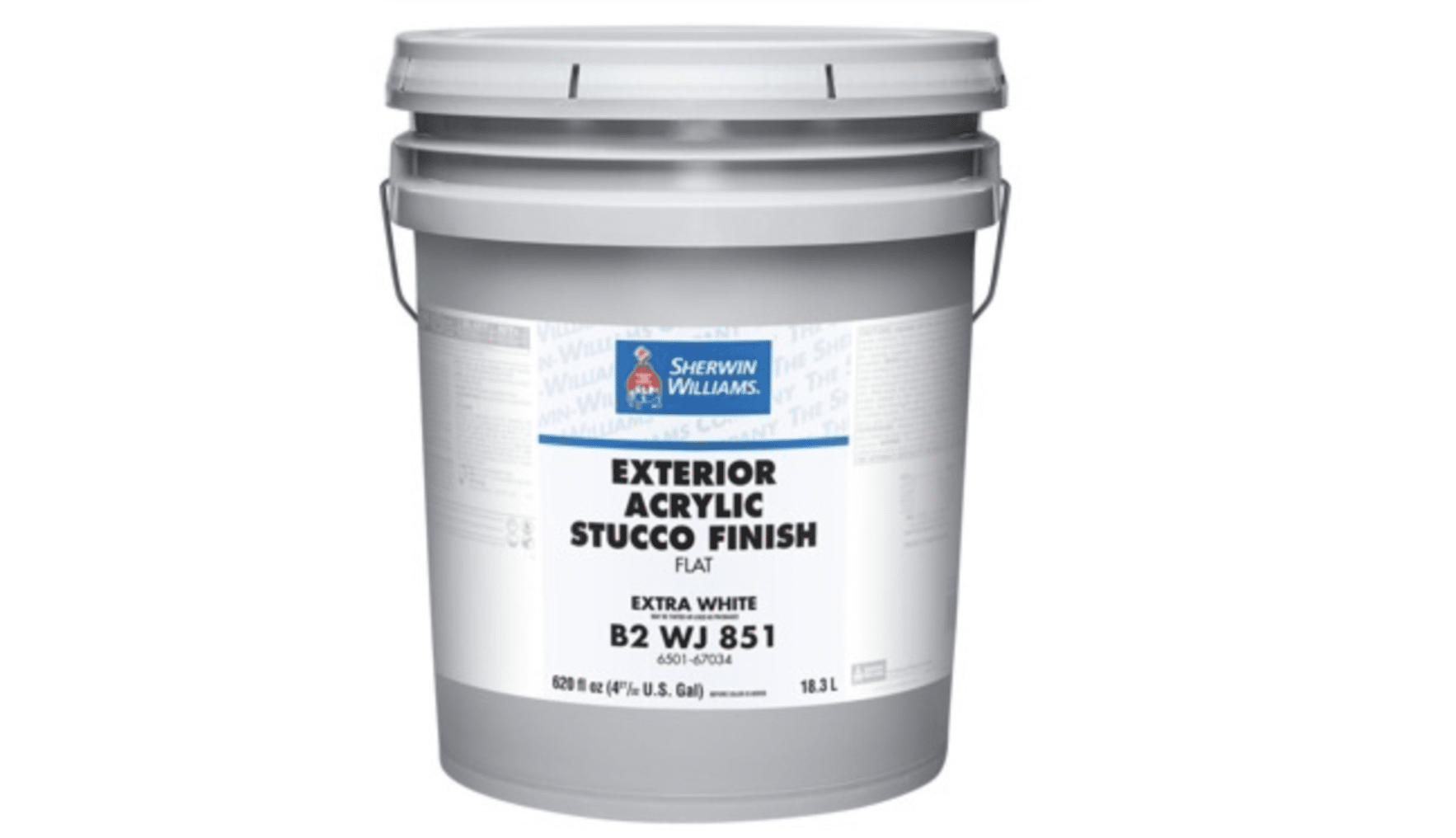
This 100% acrylic stucco finish is made for professional painters who need a high-solid content coating for maximum build on exterior stucco. The paint can handle high-pH stucco (up to 13), which makes it suitable for newly applied stucco that’s still curing. Its flat finish helps maintain the natural look of stucco surfaces.
- Works on many surfaces, including wood siding, Hardie board, and stucco
- High solids content builds well on exterior applications
- Designed for professional-quality results and durability
Essential Tools and Equipment for Painting Stucco
Before starting your stucco painting project, make sure you have all the necessary tools and equipment. The right tools will help ensure a professional-looking finish and make the job much easier.
| Category | Tools | Purpose |
|---|---|---|
| Cleaning Equipment | Pressure washer (1500-2000 PSI), Stiff bristle brush, TSP (trisodium phosphate) cleaner, Garden hose with spray nozzle, Bucket, and rags | To thoroughly clean the stucco surface and remove dirt, mold, and loose particles before painting |
| Repair Tools | Stucco patch compound, Putty knife or trowel, Sandpaper (rough grit), Wire brush | For fixing cracks, holes, and damaged areas in the stucco before applying paint |
| Protection Materials | Painter’s tape, Plastic sheeting, Drop cloths, Utility knife | To protect windows, doors, trim, and other areas that should not be painted |
| Application Tools | Long-nap rollers (¾ to 1½ inch), Stucco brushes (4-5 inch wide), Roller frames and extensions, Paint sprayer (for large jobs), 5-gallon buckets, Paint stirrers, Paint strainer | For applying primer and paint evenly to the textured stucco surface |
| Safety Gear | Eye protection, Dust mask or respirator, Work gloves, Sturdy shoes, Hat for sun protection | To protect yourself during the cleaning, preparation, and painting process |
Having all these tools ready before you start will save time and help you complete your stucco painting project more efficiently.
Step-by-Step Guide to Painting Stucco
Painting stucco requires careful preparation and application to ensure lasting results. Follow these five key stages for professional-quality results:
Step 1 – Preparation: Clean the Surface Thoroughly
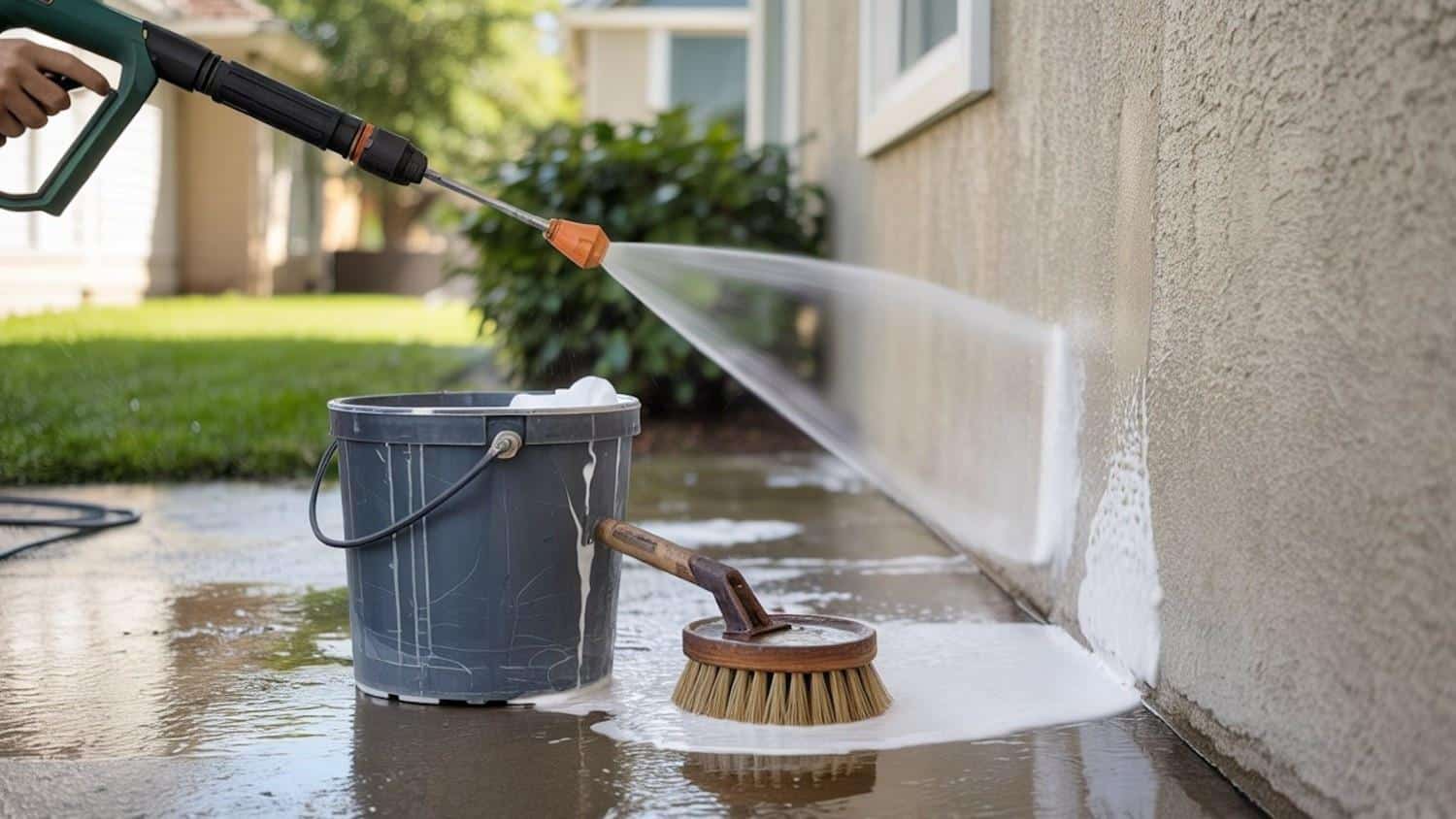
Start by checking the weather forecast and planning for 2-3 dry days.
Clean the stucco thoroughly by first wetting the surface, then applying a TSP cleaning solution with a stiff brush to remove dirt, mildew, and loose particles.
Rinse well with a garden hose or low-pressure washer, being careful not to damage the stucco texture. Allow the surface to dry completely for at least 24 hours before moving to the next step.
Step 2 – Repairs: Fill Any Cracks or Holes
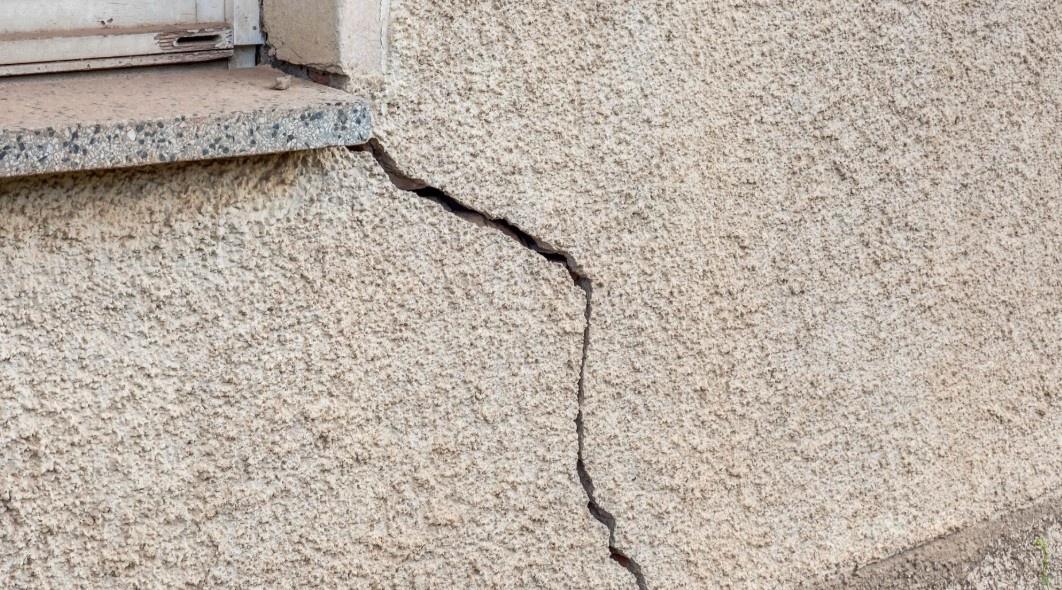
Inspect the entire stucco surface for cracks, holes, and damaged areas. Remove any loose or flaking material with a wire brush, then clean out the damaged areas.
Apply stucco patch compound to small cracks and holes using a putty knife or trowel, feathering the edges to blend with the surrounding surface.
For larger repairs, you may need to use a proper stucco mix. Allow all patches to dry completely according to the manufacturer’s instructions before continuing.
Step 3 – Priming: Apply a Suitable Primer if Necessary
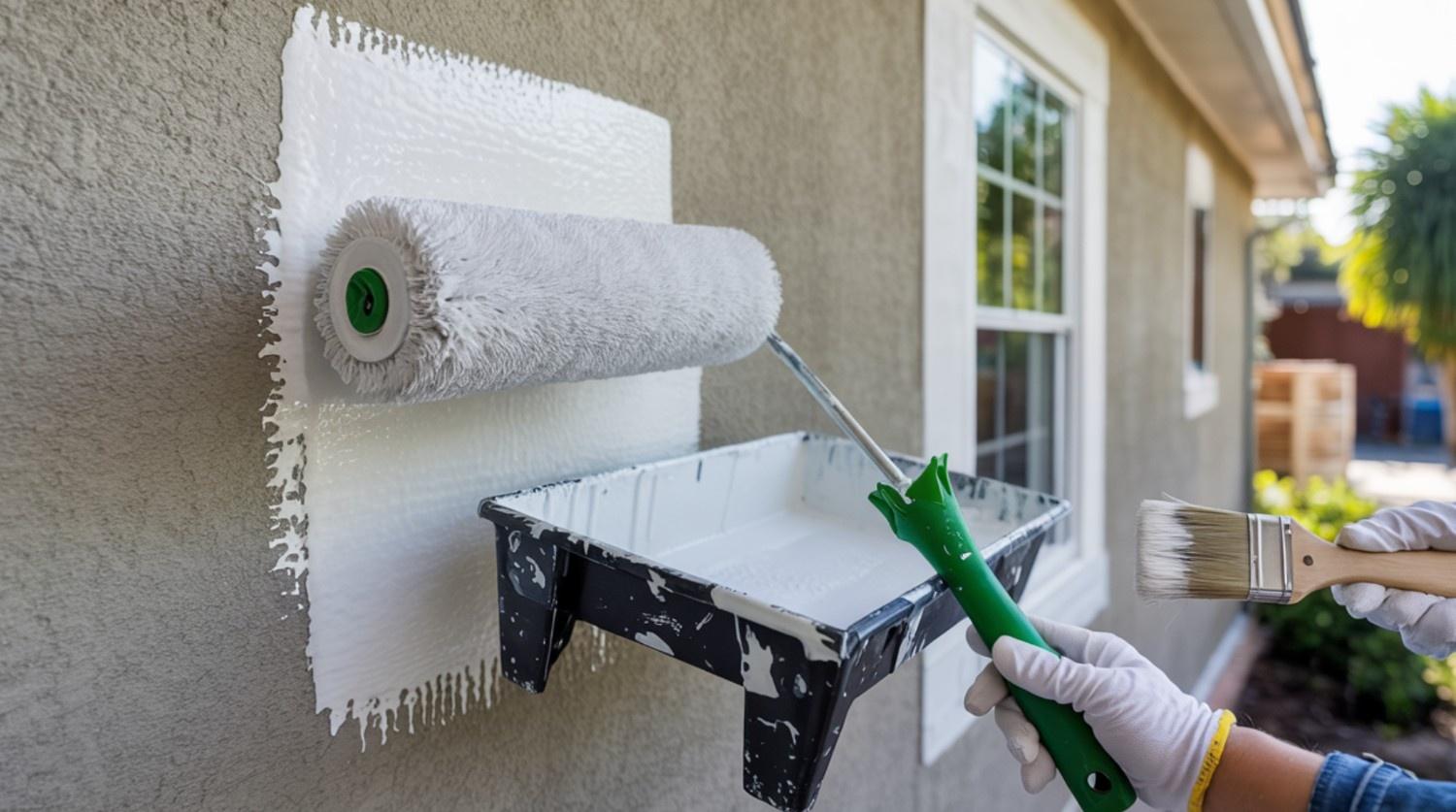
Determine if your chosen paint requires a primer—some specialty stucco paints are self-priming.
If needed, select a primer designed specifically for masonry surfaces and apply it using a thick-nap roller to work it into the texture.
Use a brush for edges and hard-to-reach areas first, then roll the main surfaces. Press firmly to ensure the primer penetrates the textured surface. Allow the primer to dry completely, typically 24 hours, before applying paint.
Step 4 – Painting: Apply Paint Using the Chosen Method
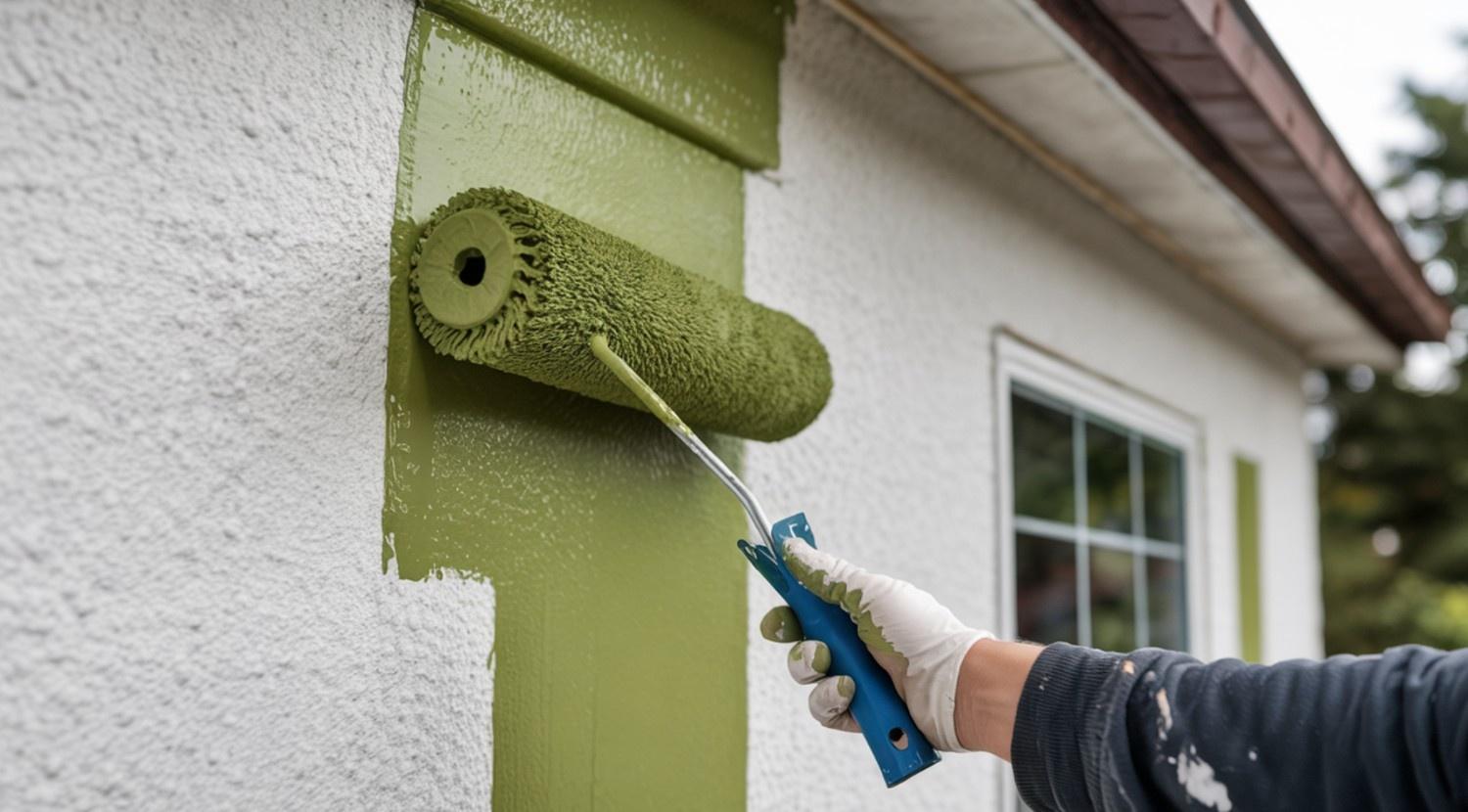
Stir the paint thoroughly instead of shaking to avoid creating bubbles. Begin at the top of the wall and work downward in manageable 4×4-foot sections.
Apply paint using a thick-nap roller with firm pressure to work it into the texture, using vertical strokes followed by horizontal strokes for even coverage.
Try to complete entire wall sections at once to prevent visible dry lines. After the first coat dries completely, apply a second coat using the same technique for complete coverage and protection.
Step 5 – Finishing Touches: Inspect and Touch up As Needed
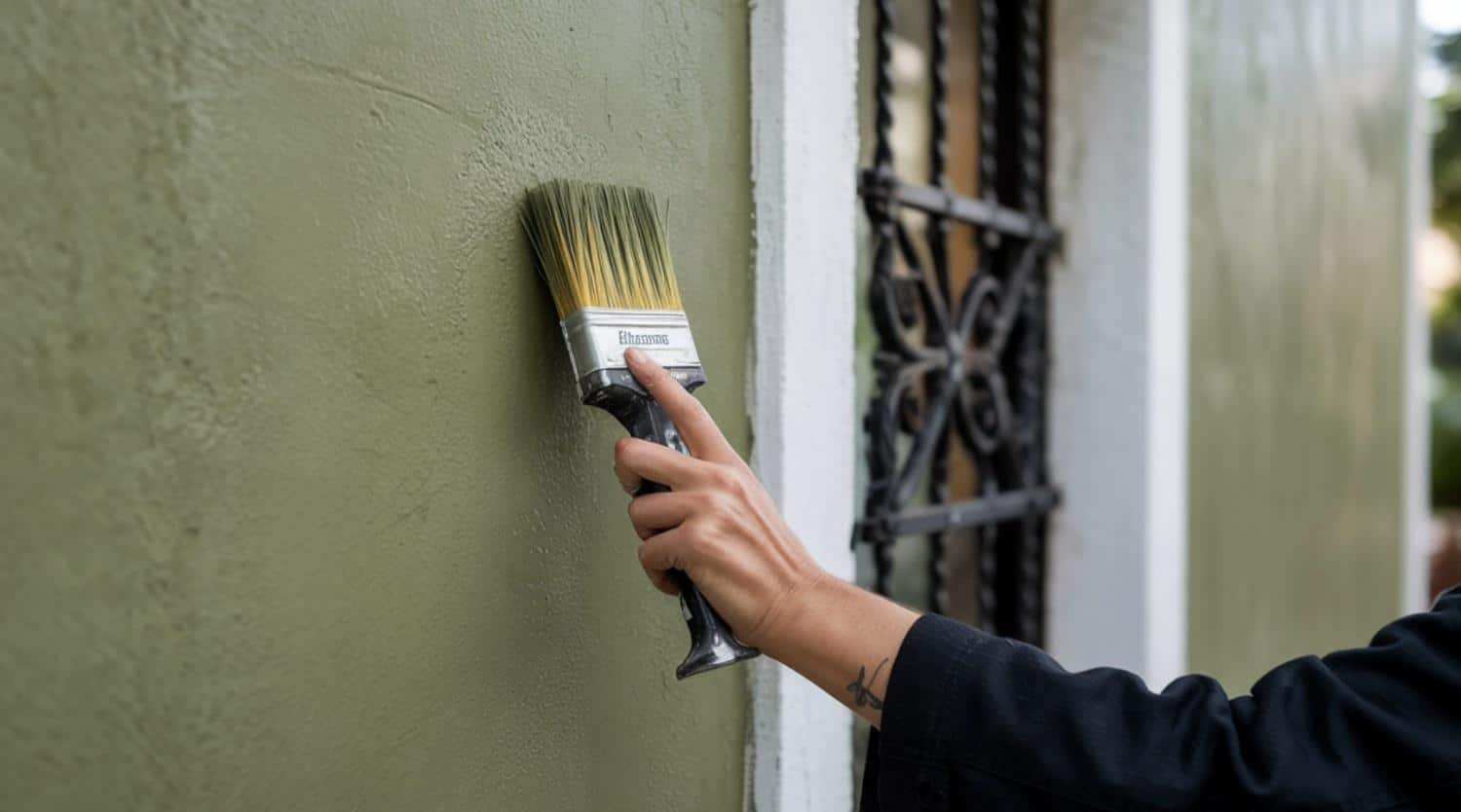
Once the paint has dried sufficiently, carefully inspect all painted surfaces in different lighting conditions to identify any missed spots, thin areas, or imperfections.
Touch up these areas with a brush, blending the edges with existing paint. Remove masking tape and protective coverings while the paint is still slightly tacky for cleaner edges.
Clean up any accidental drips or overspray on adjacent surfaces before they dry completely. Allow the paint to cure fully before exposing it to harsh weather.
Maintenance Tips for Long-Lasting Stucco Paint
- Fix small cracks as soon as you spot them to prevent water penetration and larger problems.
- Touch up worn or faded areas before they allow moisture to reach the stucco beneath.
- Keep plants at least 1-2 feet away from stucco walls to reduce moisture and prevent staining.
- Fix roof leaks and gutter problems immediately, as they can cause water damage to stucco.
- Check for water stains, dark spots, or chalky residue as early warning signs of problems.
- Store leftover paint properly labeled for future touch-ups and repairs.
- Remove stains, bird droppings, and plant debris promptly to prevent permanent marking.
Conclusion
Finding the right paint for stucco can make all the difference to your home’s look and protection.
The five options we’ve explored—from elastomeric coatings to acrylic finishes—each offer unique benefits for different stucco conditions and climate needs.
Remember that proper preparation is just as important as the paint itself. Taking time to clean, repair, and prime your stucco will ensure much better results and longer-lasting protection.
Regular maintenance, like yearly gentle washing and prompt repairs of small cracks, will extend the life of your paint job significantly. Keep an eye out for warning signs like water stains or chalky residue that might indicate problems.
Have you used any of these stucco paints on your home? Share your experience in the comments below!
Frequently Asked Questions (FAQs)
Is Painting Over Stucco a Good Idea?
Yes, painting stucco is a good idea. It adds protection against moisture damage, prevents cracking, extends the life of the stucco, and refreshes your home’s appearance.
Do I Need to Prime Stucco Before Painting?
Not always. Some specialty stucco paints are self-priming. For regular paints, primer is recommended, especially on new stucco or surfaces with repairs and patches.
How Long Will Paint Last on Stucco?
Depending on the paint type and climate, stucco paint typically lasts 5-10 years. Elastomeric and silicone paints last longer (8-10+ years), while acrylic latex averages 5-7 years.

